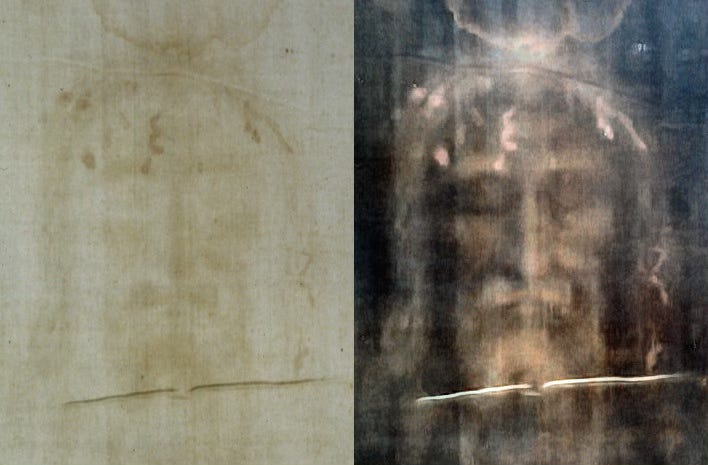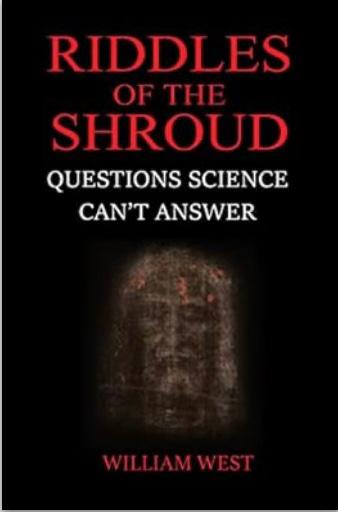I have been reading Riddles of the Shroud: Questions Science Can’t Answer by William West, a really enjoyable and informative book about the Shroud of Turin.
This website has some great high resolution photos of the shroud:
There are quite a few very notable Shroud researchers who have become believers.
In the gospels
A linen burial cloth is mentioned in the gospels.
The linen cloth was provided by the rich man whose tomb Jesus was buried in, Joseph of Arimathea.
Joseph bought a linen cloth, took Him down, wrapped Him in the linen cloth and laid Him in a tomb which had been hewn out in the rock; and he rolled a stone against the entrance of the tomb. Mark 16:46
The linen cloth was lying there by itself.
Then Simon Peter came, following him, and went into the tomb. He saw the linen cloth lying there, and the face cloth, which had been on Jesus' head, not lying with the linen cloth but folded up in a place by itself. Then the other disciple, who had reached the tomb first, also went in, and he saw and believed; for as yet they did not understand the Scripture, that he must rise from the dead. John 20:6-9
The history of the Shroud
In the West the shroud has only been known since it was stolen from Constantinople in 1206 and taken to France, apparently, among the pillages of the crusade.
However, there is a good argument that the shroud was known in the First and Second Century as the “Image not made by human hands,” and is mentioned by Athanasius, Bishop of Alexandria in a sermon written in 141AD; Athanasius said that in the year 68 an 'image of our Lord and Saviour at full length' was moved from Jerusalem to Edessa in Syria. The sermon stated that the image remained "to this day" in Syria. Of course, the year of removal was fortuitous: Jerusalem was destroyed in 70AD and this image would have been also.
Forensic Evidence
The blood is human blood, for it contains particular antibodies unique to humans, and the particular pattern of coagulation suggests that the cloth was put over the naked body after death, according to forensic pathologists who have examined the shroud.
The pattern of the wounds is particularly interesting: the nails go through the wrists, not through the palms of the hand, which is very significant: it has only been known since crucifixion victims were dug up in the twentieth century and various other studies done that nails through the palms of the hand (as usually depicted in Christian art) are not capable of holding up a body: the Romans put the nails through the wrists. The thumbs are not visible; this may be because of the way the thumbs would fold in, in reaction to the nail being hammered in. The head wounds indicate a large crown of thorns. Everything about the wounds matches the gospels. There is actually invisible plasma around the blood stains, especially around the wound in the side, where the spear went in.
A photographic negative
The means by which the image of Jesus’ face and body was created is unknown; however it is now acknowledged that it was not created by any known artistic method. What is particularly interesting is that the image is a photographic negative; something that was only discovered in 1898 when the image was first photographed.

Nobody in any age before the modern age knew anything about photography or photographic negatives, which strongly suggests authenticity.
Amazingly, there is also depth information in the image upon the shroud, i.e. it is 3D, which seems to be related to the way the image was formed, with places where the body was a further distance having less brightness. This image information has been translated into a statue of the figure on the shroud:
Carbon Dating — unreliable evidence from the 1988 fiasco
There are many questions about the 1988 carbon dating fiasco, in which it was claimed the shroud dated from the middle ages — finally after many FOI requests the British Museum released their records recently, showing that the carbon dating was actually highly inconsistent — it turns out that the piece of cloth examined had actually been repaired in the middle ages with cotton, and was the place where clergy held the shroud with their grubby medieval fingers when displaying it. Furthermore, this was the only place examined — the five researchers were supposed to be given bits of cloth from five places on the shroud and were not.
This video discusses this issue in some depth:
Russ Breault, the expert in the video, has written a book also; I haven’t read it, except for part of the chapter on Hitler’s fascination with the shroud, which is very interesting.
In William West’s book, however, in the penultimate chapter, West gives 99 reasons to believe the shroud is genuine, and the weight of evidence seems to indicate that it is. Indeed, it is up to skeptics to show how the image was created, why someone in the medieval era would even think to create a photographic negative, how the forensically accurate bloodstains arose, how they found a Jewish model to make this image from who was clearly a strong, muscular man; a carpenter perhaps? - in the middle ages, when most Jews were involved in financial businesses out of necessity, why the nails are in the wrists (historically accurate) not the palms as in all the medieval and renaissance images, etc, etc.
I found the book very moving to read, as well. The sufferings of Jesus on the cross were brought home to me in a very real, personal way, and also the Lord’s physicality — He was and is a tall, strong, muscular man, which seems to accord with many of the details of the gospels: if He was a short, little guy, I don’t think the authorities would have been so worried about arresting him. And the possibility that we have evidence of the Resurrection here, in the image ‘not formed by human hands’ is really compelling to me.
https://www.amazon.com.au/Riddles-Shroud-Questions-science-answer-ebook/dp/B0B1BQ8X7M




After watching John Campbell, it hit me as to how strong the evidence is. If in court I'd say beyond reasonable doubt. I look forward to seeing him but a sneak view is welcome.
I find it quite interesting that the shroud is mentioned in 141 CE anf that it was removed from Jerusalem in 68 CE. I was totally unaware of this. I am a believing Christian but had always been skeptical of the authenticity of the shroud.